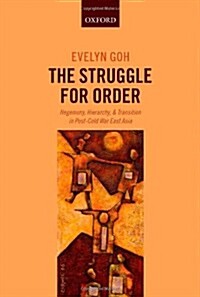
단행본
(The) struggle for order: hegemony, hierarchy, and transition in post-Cold War East Asia
- 개인저자
- by Evelyn Goh
- 발행사항
- Oxford: Oxford University Press, 2013
- 형태사항
- xvii, 267 p. ; 24 cm
- ISBN
- 9780199599363
- 청구기호
- 349.4201 G614s
- 서지주기
- Includes bibliographical references and index
- 주제
- Hegemony
소장정보
| 위치 | 등록번호 | 청구기호 / 출력 | 상태 | 반납예정일 |
|---|---|---|---|---|
이용 가능 (2) | ||||
| 1자료실 | 00014520 | 대출가능 | - | |
| 1자료실 | 00015213 | 대출가능 | - | |
이용 가능 (2)
- 등록번호
- 00014520
- 상태/반납예정일
- 대출가능
- -
- 위치/청구기호(출력)
- 1자료실
- 등록번호
- 00015213
- 상태/반납예정일
- 대출가능
- -
- 위치/청구기호(출력)
- 1자료실
책 소개
Arguing that existing ideas about balance of power and power transition are inadequate, this book gives an innovative reinterpretation of the changing nature of U.S. power, focused on the 'order transition' in East Asia.
How has world order changed since the Cold War ended? Do we live in an age of American empire, or is global power shifting to the East with the rise of China? Arguing that existing ideas about balance of power and power transition are inadequate, this book gives an innovative reinterpretation of the changing nature of U.S. power, focused on the 'order transition' in East Asia. Hegemonic power is based on both coercion and consent, and hegemony is crucially underpinned by shared norms and values. Thus hegemons must constantly legitimize their unequal power to other states. In periods of strategic change, the most important political dynamics centre on this bargaining process, conceived here as the negotiation of a social compact. This book studies the re-negotiation of this consensual compact between the U.S., China, and other states in post-Cold War East Asia. It analyses institutional bargains to constrain and justify power; attempts to re-define the relationship between a regional community and the global economic order; the evolution of great power authority in regional conflict management, and the salience of competing justice claims in memory disputes. It finds that U.S. hegemony has been established in East Asia after the Cold War mainly because of the complicity of key regional states. But the new social compact also makes room for rising powers and satisfies smaller states' insecurities. The book controversially proposes that the East Asian order is multi-tiered and hierarchical, led by the U.S. but incorporating China, Japan, and other states in the layers below it.
How has world order changed since the Cold War ended? Do we live in an age of American empire, or is global power shifting to the East with the rise of China? Arguing that existing ideas about balance of power and power transition are inadequate, this book gives an innovative reinterpretation of the changing nature of U.S. power, focused on the 'order transition' in East Asia. Hegemonic power is based on both coercion and consent, and hegemony is crucially underpinned by shared norms and values. Thus hegemons must constantly legitimize their unequal power to other states. In periods of strategic change, the most important political dynamics centre on this bargaining process, conceived here as the negotiation of a social compact. This book studies the re-negotiation of this consensual compact between the U.S., China, and other states in post-Cold War East Asia. It analyses institutional bargains to constrain and justify power; attempts to re-define the relationship between a regional community and the global economic order; the evolution of great power authority in regional conflict management, and the salience of competing justice claims in memory disputes. It finds that U.S. hegemony has been established in East Asia after the Cold War mainly because of the complicity of key regional states. But the new social compact also makes room for rising powers and satisfies smaller states' insecurities. The book controversially proposes that the East Asian order is multi-tiered and hierarchical, led by the U.S. but incorporating China, Japan, and other states in the layers below it.


